ATI's New High End and Mid Range: Radeon X1950 XTX & X1900 XT 256MB
by Derek Wilson on August 23, 2006 9:52 AM EST- Posted in
- GPUs
A Matter of Memory: Revisiting the Mid-Range
When 512MB cards first came along (with the GeForce 7800 GTX 512), we ran some performance tests to try and ascertain the real world performance difference between these cards and ones with 256MB of RAM. We came up empty handed at the time. Today we are able to show that memory sizes above 256MB are actually starting to matter. With ATI's launch of the new X1900 XT 256MB, we have a direct comparison between two cards which are almost identical aside from the amount of memory on board. To be completely fair, X1900 XT 256MB cards built by ATI will also have full HDCP support, keys and all, but the major difference remains RAM.
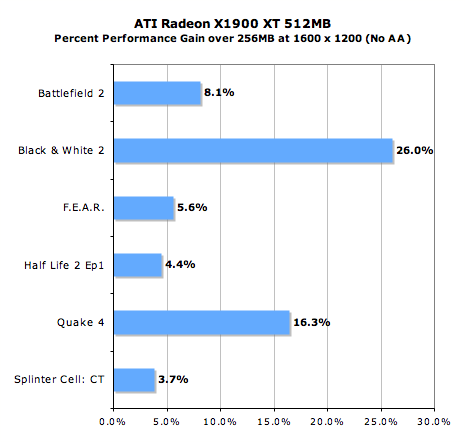
ATI dropped down to eight 8Mx32 as opposed to the eight 16Mx32 GDDR3 modules used on the original X1900 XT. Memory speed, bandwidth, and even layout can remain the same between cards, with only a slight difference in timings due to the different capabilities of each chip type. The result is that the X1900 XT 256MB is a slower solution than the X1900 XT that still offers exceptional performance for a terrific price.
The graphs below compare the new $279 X1900 XT 256MB to the rest of the sub-$300 cards we included in last week's mid-range GPU roundup. Note that the X1900 XT's chief competitor is NVIDIA's GeForce 7900 GT, which itself can be found for around $270. However, for as little as $20 more you can get a factory overclocked 7900 GT such as the eVGA GeForce 7900 GT KO SC clocked at 580/790 that all of the sudden becomes far more competitive. Because of the prevelance of factory overclocked (and warrantied) 7900 GTs, we've included the eVGA card as a reference of what you can get for the same price.
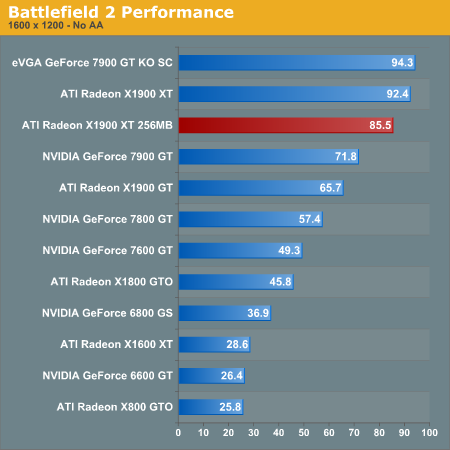
The 256MB drop in memory size doesn't impact BF2 enough to drop performance below the 7900 GT. The overclocked EVGA card does out perform even the 512MB X1900 XT in this test, but the 256MB version doesn't loose much value here as 85 fps is still way more than playable.
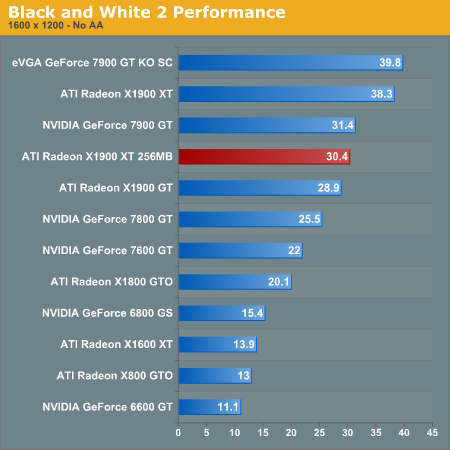
The 256MB X1900 XT falls in performance to just below the level of the stock 7900 GT. The competition is still tight, and we are about on par for the money here.
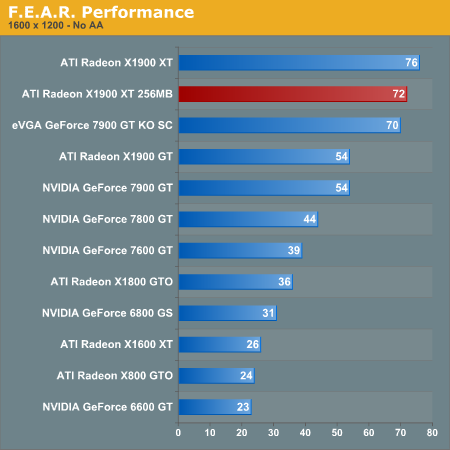
If F.E.A.R. performance is important to you, the X1900 XT 256MB is a better value than even the overclocked 7900 GT. The 512MB card still retains a small 5.5% lead over the 256MB card. This is one of the smaller performance drops we will see.
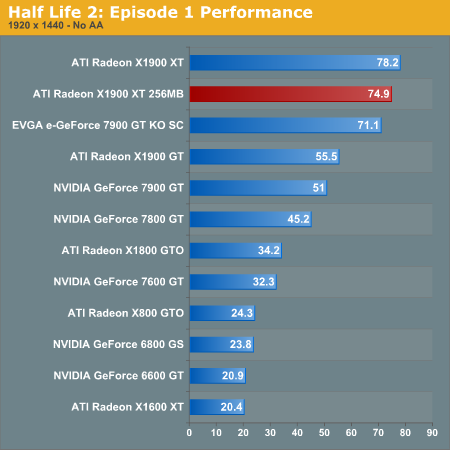
Under HL2:Ep1, performance drops a very small amount, but both X1900 XT cards are in strong competition with the overclocked 7900 GT.
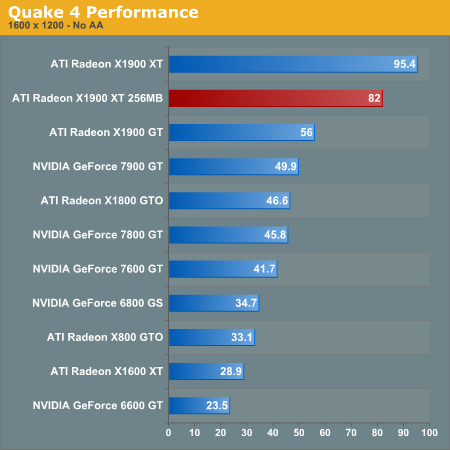
Quake 4 does give the 512MB card a bit of an advantage at 1600 x 1200, but the performance of the 256MB X1900 XT is still quite respectable given its target price of $279. The stock GeForce 7900 GT isn't in the same league as the X1900 XT.
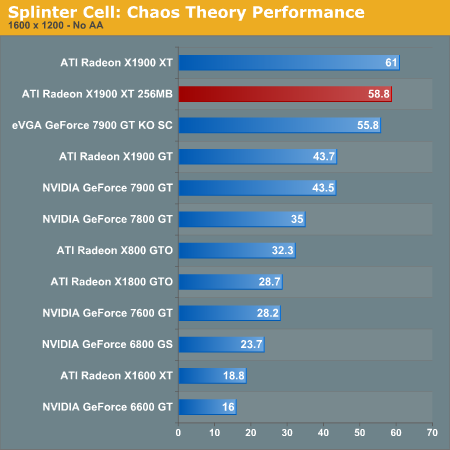
Spinter Cell rounds out our tests as one of those games where the larger frame buffer on the older X1900 XT does not do much. You lose less than 4% of your performance when going to the cheaper 256MB X1900 XT, which is a trade off we can live with. The regular GeForce 7900 GT can't hope to keep up with the 256MB X1900 XT, but if you get one of the factory overclocked cards such like the eVGA GeForce 7900 GT KO SC (more acronyms please) then you'll actually have performance competitive to the X1900 XT 256MB.
If the X1900 XT 256MB actually debuts at the ATI suggested price of $280, there won't be much of a reason to recommend anything but ATI parts from $220 up until we reach the highest end parts at above $400 where the lines start to blur again. While performance can fall very short of the X1900 XT 512MB at times, the X1900 XT 256MB remains competitive with our overclocked 7900 GT in every case but Black & White 2. The reduced memory version of the X1900 XT is just what ATI needed to pull out in order to fight back against the incredible overclockability of the 7900 GT.










74 Comments
View All Comments
DerekWilson - Saturday, August 26, 2006 - link
yeah ... i didn't test power with crossfire -- which is a whole lot higher. also, i have a minimal set of componets to make it work -- one hdd, one cdrom drive, and no addin cards other than graphics.we'll do multi-gpu power when we look at quadsli
ElFenix - Thursday, August 24, 2006 - link
the review states that power consumption was measured at the wall wtih a kill-a-watt, during a 3Dmark run.in addition to the water cooling, it could be he's running a more efficient PSU. in a powerful system drawing 220 watts from the power supply would draw 277 watts from the wall with an 80% efficient PSU (like a good seasonic) and draw 314 watts with a 70% efficient PSU. that's a pretty decent difference right there.
... still waiting for nvidia's HQ driver run...
poohbear - Thursday, August 24, 2006 - link
thanksRock Hydra - Wednesday, August 23, 2006 - link
With those competitively price parts, hopefully nVIDIA will respond with lower prices.CreepieDeCrapper - Wednesday, August 23, 2006 - link
I'm not familiar with 1920x1440, did you mean 1920x1200? What resolution were these tests performed? Thank you!JarredWalton - Wednesday, August 23, 2006 - link
1920x1440 is a standard 4:3 aspect ratio used on many CRTs. It is often included as performance is somewhat close to 1920x1200 performance.CreepieDeCrapper - Wednesday, August 23, 2006 - link
Thanks, I've been using my LCD for so long I forgot about the vintage CRT res's out there ;) Plus I never ran that particular res on my CRT when I had one, so I just wasn't familiar.cgaspar - Wednesday, August 23, 2006 - link
While average frame rates are interesting, I _really_ care about minimum frame rates - 300fps average is useless if at a critical moment in a twitch game the frame rate drops to 10fps for 3 seconds - this is especially true in Oblivion. Of course it's possible that the minimums would be the same for all cards (if the game is CPU bound in some portion), but they might not be.JarredWalton - Wednesday, August 23, 2006 - link
A lot of games have instantaneous minimums that are very low due to HDD accesses and such. Oblivion is a good example. Benchmarking also emphasizes minimum frame rates, as in regular play they occur less frequently. Basically, you run around an area for a longer period of time in actual gaming, as opposed to a 30-90 second benchmark. If there's a couple seconds at the start of the level where frame rates are low due to the engine caching textures, that doesn't mean as much as continuos low frame rates.More information is useful, of course, but it's important to keep things in perspective. :)
kmmatney - Wednesday, August 23, 2006 - link
The charts show tht the 7900GT gets a huge boost from being factory overclocked. It would be nice to see if the X1900XT 256 MB can also be overclocked at all, or if there is any headroom.